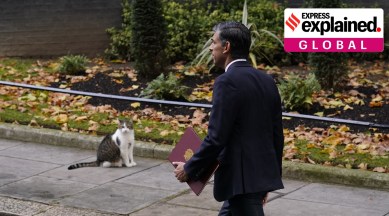Udit Misra is Senior Associate Editor. Follow him on Twitter @ieuditmisra ... Read More
© The Indian Express Pvt Ltd

On Tuesday, Rishi Sunak took charge as the 57th Prime Minister of the United Kingdom. He is the country’s third PM in 50 days after first Boris Johnson and then Liz Truss were forced from office by a rebellion within the ruling Conservative Party. Sunak takes over the reins at a time when the UK is facing one of its gravest economic and political crises in recent memory.
In his first address, Prime Minister Sunak said: “Our country is facing a profound economic crisis. The aftermath of Covid still lingers. Putin’s war in Ukraine has destabilised energy markets and supply chains the world over”.
Promises in Tory manifesto
Prime Minister Sunak committed to delivering on the Conservative Party’s 2019 election manifesto. The Tories had won under the leadership of Johnson, with the promise to “get Brexit done”, and to follow through with the goal of making Britain stronger and “unleashing [its] potential”. This is what the manifesto promised:
However, all this was before the twin shocks of the Covid-19 pandemic and the war in Ukraine, which dented the British economy and upended the government’s fiscal math.
The UK’s cascading crises
A STAGNANT ECONOMY: The UK’s economic problems began long before Sunak had even joined politics. (He became an MP in 2015.)
In terms of overall output (in US$), the economy has been largely stagnant since the start of the 2008 Global Financial Crisis, which hit one of the UK’s biggest growth drivers — the financial centre of London.
The decision to leave the EU made matters worse. It became tougher for the UK to trade with its closest trading partners in Europe. The higher compliance costs hit small businesses, and several businesses were forced to move out of the UK in order to protect their market share.
It was in this phase of reduced GDP per capita and reduced GDP per person employed, that the Covid disruption and the war in Ukraine hit the British economy.
DERAILED GOVERNMENT FINANCES: According to an analysis by the Institute of Fiscal Studies in the UK, “In 2018–19, revenues were sufficient to cover day-to-day (‘current’) spending for the first time since 2001–02, meaning that the government was only borrowing for investment spending”. But thanks to increased “spending to mitigate the economic impact of the pandemic and associated lockdowns on households, businesses and public services”, this ratio of revenues to current spending went from a surplus to a deficit of over 11% (of the national income) within two years.
The sharp worsening of public finances essentially meant that in the years to come, the government would have to cut spending and raise revenues to balance its books. That in turn would require a new round of austerity for public services — be it health, education, or policing. It would involve difficult and politically sensitive decisions such as asking nurses, who had risked their lives during the pandemic, to settle for lower-than-promised raises.
GROWING COST OF LIVING CRISIS: The war in Ukraine set off an unexpected energy price inflationary spiral. The UK’s retail inflation, which typically stayed below 2.5% (often below 1%), skyrocketed to double-digit historic highs.
Coming on the back of reduced incomes and livelihoods, this inflationary spike morphed into a broader “cost of living” crisis — which is essentially a decline in purchasing power. This has triggered labour action across several segments of British life — workers in the railways, royal mail, docks, education, nursing, etc. — are either already on strike or threatening to go on strike.
THE ‘MORON’ PREMIUM: The final straw that broke the camel’s back was the Truss-Kwasi Kwarteng decision to increase spending (including giving tax cuts to the richest) by simply borrowing more.
This spooked the markets; investors sold British assets such as gilts (government bonds) and currency. The resultant fall in the pound’s exchange rate made imports even costlier and the sale of gilts meant that interest rates across the economy skyrocketed. The increased interest rates are being referred to as the “moron premium” that all British borrowers have to pay.
Sunak’s loaded in-tray
The Prime Minister has no time to settle into his job. As he seeks to hit the ground running, there are three major challenges that he must address immediately.